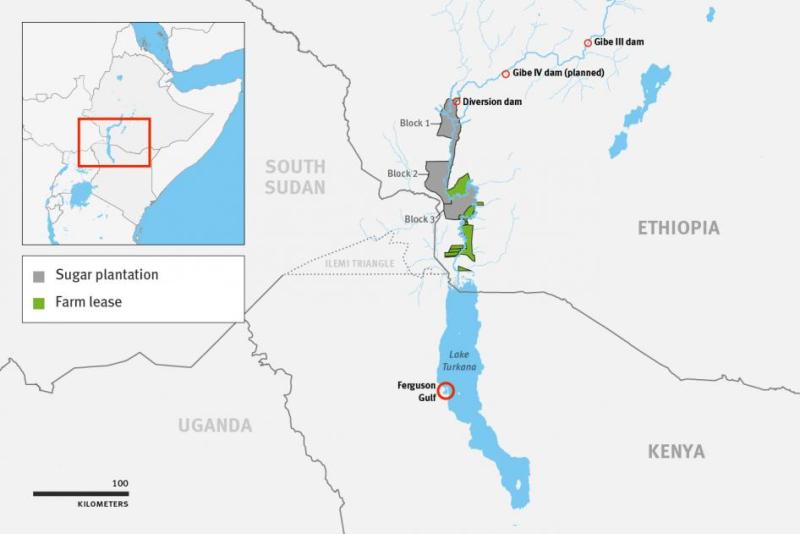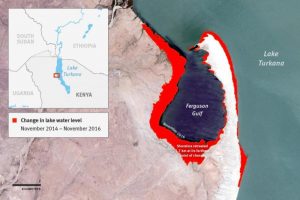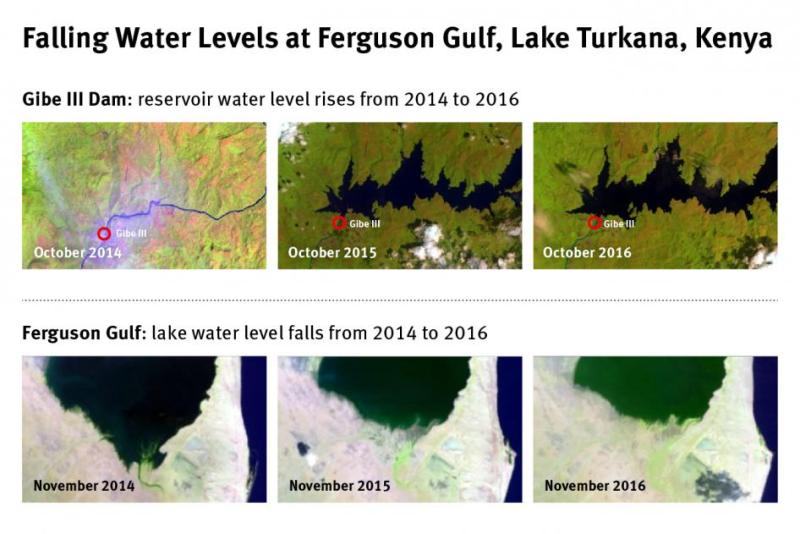By Human Rights Watch Press
Published February 14, 2017
 The development of dams and plantations in Ethiopia’s lower Omo Valley threaten the livelihoods of half a million indigenous people in Ethiopia and Kenya.
The development of dams and plantations in Ethiopia’s lower Omo Valley threaten the livelihoods of half a million indigenous people in Ethiopia and Kenya.
The water levels of Lake Turkana in northern Kenya have dropped by 1.5 metres since January 2015 and further reduction is likely without urgent efforts to mitigate the impact of Ethiopia’s actions. Research based on satellite imagery shows that the drop is already affecting the shoreline of the lake, which has receded as much as 1.7 kilometres in Ferguson Gulf since November 2014. The Gulf is a critical fish-breeding area, and a key fishing ground for the indigenous Turkana people.
“The predicted drop in the lake levels will seriously affect food supplies in the Omo Valley and Lake Turkana, which provide the livelihoods for half a million people in both Kenya and Ethiopia,” says Felix Horne, senior Africa researcher at Human Rights Watch. “The Ethiopian government’s moves to develop its resources should not endanger the survival of indigenous people living downstream.”
RELATED:Power Project Threatens Indigenous Peoples in Ethiopia and Kenya
 In 2015, the reservoir behind the new Gibe III dam in Ethiopia began filling. Water that previously flowed unimpeded into Lake Turkana, replenishing seasonal drops in lake levels, has since been held behind the Gibe III dam. In 2015 the annual July-November flood from the Omo River into Lake Turkana did not occur, resulting in a drop of water levels of 1.3 metres from November 2014. The very limited artificial release of water from Gibe III in 2016 was not enough to replenish water levels in Lake Turkana. As of January 30, 2017, lake levels were 1.5 metres lower than they were two years earlier.
In 2015, the reservoir behind the new Gibe III dam in Ethiopia began filling. Water that previously flowed unimpeded into Lake Turkana, replenishing seasonal drops in lake levels, has since been held behind the Gibe III dam. In 2015 the annual July-November flood from the Omo River into Lake Turkana did not occur, resulting in a drop of water levels of 1.3 metres from November 2014. The very limited artificial release of water from Gibe III in 2016 was not enough to replenish water levels in Lake Turkana. As of January 30, 2017, lake levels were 1.5 metres lower than they were two years earlier.
RELATED: Fish Finder Reviews
The Kenyan government has done little to address the impact from Ethiopia’s Omo Valley development, or to press Ethiopia to take steps to mitigate the damage and to consult with and inform affected communities about the impact of the project. The governments of Kenya and Ethiopia should urgently work with these communities to ensure upstream industrial works does not devastate their livelihoods, Human Rights Watch says.
 “The Ethiopian government has shown scant regard for the lives and livelihoods of already marginalised communities who are reliant on the Omo River and Lake Turkana for their livelihoods,” Horne says. “In its rush to develop its resources it has not developed strategies to minimise the impact on those living downstream.”
“The Ethiopian government has shown scant regard for the lives and livelihoods of already marginalised communities who are reliant on the Omo River and Lake Turkana for their livelihoods,” Horne says. “In its rush to develop its resources it has not developed strategies to minimise the impact on those living downstream.”
Ethiopia’s Gibe III dam, which opened on December 17, 2016, is a key component of a massive industrial project in the lower Omo Valley that includes a cascade of water-intensive mega dams, and sugar and cotton plantations. The sugar plantations have been under development in the Omo Valley since 2011. Approximately 19500 hectares of land has been cleared on the east bank of the river for sugar plantation development. An additional 10500 hectares has been prepared for irrigation on the west bank. The sugar plantations are planned to be 100000 hectares. According to the Ethiopian Sugar Corporation, the first of the four sugar processing factories should be ready to begin production in early 2017.
RELATED:Nairobi and Addis Ababa Draw Closer as Trading Partners
In Ethiopia, livelihoods of those living in the Omo Valley depend on cattle grazing and planting crops in the rich alluvial soil along the banks of the Omo River. This alluvial soil is replenished by the annual flood, which deposits water and nutrient rich sediment along the banks. A lack of floods in 2015 and an inadequate artificial flood in 2016 are making it more difficult to grow food along the Omo River.
 Some communities have also reported restricted access to the Omo River and food shortages in 2016. Furthermore, the plantations necessitate clearing of land used by agro-pastoral indigenous groups including the Bodi and the Mursi. The Bodi have been the most heavily affected, with a significant area of their land cleared.
Some communities have also reported restricted access to the Omo River and food shortages in 2016. Furthermore, the plantations necessitate clearing of land used by agro-pastoral indigenous groups including the Bodi and the Mursi. The Bodi have been the most heavily affected, with a significant area of their land cleared.
RELATED:Dam to Displace Millions in Omo/Turkana Basin
“The projections of the water drawdown on Lake Turkana, routinely rubbished by Ethiopia’s government, are coming true and lake levels have started dropping,” Horne says. “This should serve as a warning about what could happen if the Ethiopian government continues to ignore the needs of downstream communities in its rush to develop its resources.”




